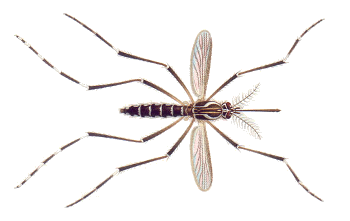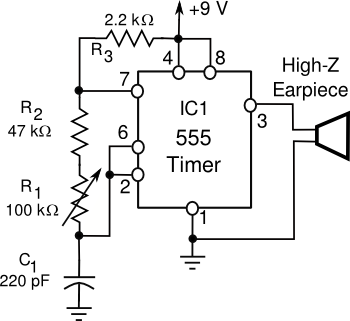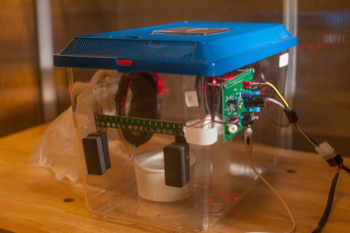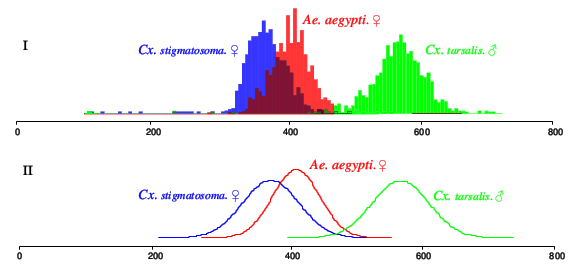The Bugs of Summer
May 14, 2014
Despite popular misconception,
New Jersey is not a
mosquito-
infested swamp. My
backyard in
Northern New Jersey is not notably infested, although there's always the general fear of
tick-borne Lyme disease, and
eastern equine encephalitis from a rogue mosquito. Our
frigid winters tend to eliminate the many
insect pests found in the
Southern States.

This small insect, the Aedes aegypti mosquito, has changed the course of human history through its transmission of yellow fever viruses, and other diseases.
(Illustration by August Goeldi (1859-1917), via Wikimedia Commons.)
Mosquito repellent devices have been sold from the earliest days of
electronics. They're all based on the idea that mosquitos are repelled by a
high frequency tone at the limits of
human audibility, about 15
kHz. Although any high frequency tone would annoy humans, and perhaps mosquitos, the idea is that certain insect
predators of mosquitos beat their
wings at that frequency.
As they say,
it looks good on paper, but do these mosquito repellent devices work? A recent study by the
Cochrane Collaboration, an international
healthcare collaboration, showed that the devices don't work.[1-2] As written in their report, "There was no evidence in the field studies to support any repelling effects of [electronic mosquito repellents], hence no evidence to support their promotion or use."[1]
There's a complementary high frequency device, called
The Mosquito, for the prevention of
loitering by
young people. The idea of this device is that its tones are only audible to younger people.

Here's my 15-minute design of a simple mosquito repellent circuit.
Many electrical engineers of my generation built similar circuits, since there's a good story behind its working principle, but scientific studies have invalidated the concept.
(Illustration by the author using Inkscape.)
I've mentioned in previous articles that
science advances not just through
theory, but by development of new
instruments with which to test these theories. A prime example of this is
Xray crystallography, which led to the structure of
DNA and a revolution in
biology. When your objective is the protection of
humans,
animals and
crops from insect pests, it's important to know what you're fighting.
Over the
decades, some inexpensive
sensors have been developed for
classification of flying insects, but these haven't had a lasting impact.[3] A team of scientists from the
University of California, Riverside, has been developing a multi-sensor approach to overcome the limitations of past work, which focused on just wingbeat frequency and limited
datasets.[3-4]
The UCR team includes
Yanping Chen, a
computer science graduate student at UCR and lead author of the study,
Eamonn Keogh, a
professor of
computer science and engineering at UCR,
Adena Why, a UCR
entomology graduate student,
Gustavo Batista of the
University of São Paulo (Brazil), and
Agenor Mafra-Neto of
ISCA Technologies (Riverside, CA).[4]
The UCR sensor also uses wingbeat frequency, but it uses an
optical method of detection that allows extraction of additional data such as flight behavior patterns.[3] This allowed a
Bayesian classification approach which is enabled by tens of million
data points obtained by dozens of sensors operating in parallel 24 hours a day over the course of three years.[4]

Pandora's Polyethylene Box
Test apparatus used by University of California, Riverside, researchers for collecting data on insect behavior.[4]
(UCR photo by Peter Phun.)
The sensor obtains data from insects flying through a
light curtain, as seen in the photograph. A
light beam passing from a
laser diode to an array of
phototransistors detects the
acoustic signature of the insect wingbeats as small
amplitude changes.[4] Interestingly, the
prototype sensor was constructed with
Legos®, a 99-cent
laser pointer, and components harvested from a
television remote control.[4]

Left, professor Eamonn Keogh holding his flying insect sensor. Right, detail of the sensor showing the light curtain in the flight opening. (Still images from a YouTube video.)
With two
species of flying insects, the UCR sensor had 99%
accuracy, declining to 96% for five species and 79% for ten species.[4] In one
experiment, wingbeat frequency alone gave 88% accuracy, but adding
time of day increased the success rate to 95 %; and, to 97% when location data were added.[4] The research team speculates that accuracy will be improved by adding other variable, such as the
height at which the insects fly,
temperature and
humidity.[4]

The reason why wingbeat frequency alone is not enough. There's considerable overlap of frequency of the species, Culex stigmatosoma and Aedes aegypti. (Fig. 1 of ref. 3, via arXiv.)
The goal of this research is the development of an inexpensive
wireless instrument that's as effective as the current methods such as sticky
traps and interception traps, but with the added advantage of being more accurate while reacting in
real time.[4] Says Keogh,
"We set out not knowing what was possible... Now, the problem is essentially solved. We have created insect classification tools that can outperform the world's top entomologists in a fraction of the time."[4]
The team's plan is to deploy the sensor more widely than its present trial sites in
Brazil and
Hawaii.
Tovi Lehmann, an entomologist with the
Laboratory of Malaria and Vector Research at the
National Institute of Allergy and Infectious Diseases (Rockville, Md.), is working with the team to deploy the sensors in
Mali.[4] This research was supported by the
Vodafone Americas Foundation, the
Bill and Melinda Gates Foundation, and the São Paulo Research Foundation.[4]
The title of this article is a
play on
The Boys of Summer, a 1984 song by
Don Henley. You can hear a live rendition of it, on
YouTube,
here. The song is apparently about lost youth and entering middle age, but
baseball players are also called the boys of summer.
References:
- Ahmadali Enayati, Janet Hemingway and Paul Garner, "Electronic mosquito repellents for preventing mosquito bites and malaria infection," the Cochrane Library 2010, Issue 3.
- William Kremer, "Ultrasound mosquito repellents: Zapping the myth," BBC World Service, December 10, 2012.
- Yanping Chen, Adena Why, Gustavo Batista, Agenor Mafra-Neto and Eamonn Keogh, "Flying Insect Classification with Inexpensive Sensors," arXiv Preprint Server. March 11, 2014)
- Sean Nealon, "Saving Crops and People with Bug Sensors," University of California, Riverside, Press Release, April 29, 2014.
- Living the Promise: Eamonn Keogh, University of California, Riverside, YouTube Video, April 9, 2012.
Permanent Link to this article
Linked Keywords: New Jersey; mosquito; infestation; infested; swamp; backyard; Morris County, New Jersey; Northern New Jersey; tick-borne disease; Lyme disease; eastern equine encephalitis; cold; frigid; winter; insect; pest; Southern United States; Aedes aegypti; human history; yellow fever virus; disease; Wikimedia Commons; Mosquito repellent; electronics; high frequency tone; human audibility; hertz; kHz; predation; predator; wing; it looks good on paper; Cochrane Collaboration; healthcare; collaboration; The Mosquito; loitering; youth; young people; electrical engineering; electrical engineer; baby boomer; my generation; Inkscape; science; theory; scientific instrument; Xray crystallography; DNA; biology; human; animal; crop; decade; sensor; categorization; classification; University of California, Riverside; dataset; Yanping Chen; computer science; graduate student; Eamonn Keogh; professor; computer science and engineering at UCR; Adena Why; entomology; Gustavo Batista; University of São Paulo (Brazil); Agenor Mafra-Neto; ISCA Technologies (Riverside, CA); optics; optical; Bayesian classification; data; data point; Pandora; polyethylene; Peter Phun; light curtain; light beam; laser diode; phototransistor; spectrogram; acoustic signature; amplitude; prototype; Legos®; laser pointer; television remote control; YouTube video; species; accuracy; experiment; time of day; altitude; height; temperature; humidity; Culex stigmatosoma; Aedes aegypti; arXiv; wireless sensor network; wireless instrument; insect trap; real time; Brazil; Hawaii; Tovi Lehmann; Laboratory of Malaria and Vector Research; National Institute of Allergy and Infectious Diseases (Rockville, Md.); Mali; Vodafone Americas Foundation; Bill and Melinda Gates Foundation; word play; The Boys of Summer; Don Henley; YouTube; baseball.